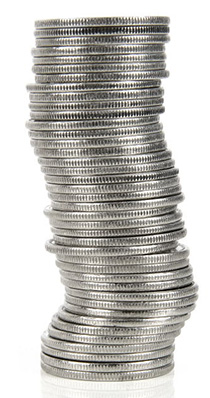PAYING IT FORWARD
Paying it forward, and back
Most American educational institutions rely on the kindness of friends (and some strangers, too) – from Stanford's chart-topping philanthropic support that sometimes reaches the $1 billion mark in just a year's time, to the vast network of state and local schools that receive major funding from both their alumni and state governments. Volunteers plan and host parties, interview prospective students, serve as ambassadors and unpaid spokespeople, provide expert advice on everything from land use to financial markets, marketing to engineering. And there are even standout small colleges like Centre and Amherst that can count on more than half their alumni making a gift to the school in a given year. What impact does giving and volunteering have on Cornell? I's doing nothing less than changing the course of the university's future, as seen in Chuck Feeney's story and Joan and Irwin Jacobs' story. But there are also smaller stories with big impact. Like the devoted staffer who goes the extra mile to help international students, or members of the Class of 1979, who rallied to make a splash on the occasion of their 35th Reunion. Cornell's future is being shaped by the kindness of Cornellians and friends today.
Busy beavers building scholarships
Of the approximately 2,300 endowed, named scholarship funds supporting Cornell undergrads, one of the biggest is thanks to the Cornell Club of Oregon and Southwest Washington. Endowed through gifts from approximately 50 Oregon and Washington alumni, including two major bequests, the scholarship has grown to almost $2 million, with an annual payout of around $85,000. Last year, the club's scholarship helped support 46 students. It is Cornell's largest alumni club scholarship, which is especially impressive when you realize that there are only 1,000 Cornellians living in the region and only 200 active club members. Map image of Oregon. Image: iStockphoto See larger image "We started it back in 1980," says Mort Bishop '74, the primary driver and caretaker of the fund. "It's just amazing," he muses, "how time flies and how an endowment builds." The club was motivated to start the scholarship after a bad year. "It started when several students were admitted but chose to go elsewhere because they felt Cornell didn't supply a competitive financial aid package," Bishop recalls. Today, all Cornell students from Washington or Oregon who have financial need are awarded some portion of the scholarship's payout. Soon after enrolling, an eligible student will get a letter in the mail from Bishop that states: "Our scholarship monies have been raised to help 'Oregon's own' at Cornell. Other Cornellians before us have provided a helping hand to the next generation of Cornellians to enjoy the benefits of a top-rated education. Hopefully, some day you will be in a position to do likewise and carry on this proud tradition of helping others in our Cornell family.'"
A superhero for international students
Sarah Hilsman '84, associate director for Student Immigration Services in the International Students and Scholars Office, is "clearly an equal-opportunity giver," in the words of one grateful graduate student. "Without her, my life at Cornell would have been 10 times harder," writes Ilil Benjamin, a student from Israel and a Ph.D. candidate in the field of science and technology studies. Sarah Hilsman '84 with students. See larger image "Sarah must have responded to over 100 of my questions about my immigration status over the past several years and spent dozens of hours investigating them personally on my behalf – including in the evenings, on weekends and in her downtime," Benjamin continues. "And I am only one student! I can only imagine how many others she must have helped in this way." "It's an ethic of the entire office to be as helpful as we can," says Hilsman. "There's a lot of frustration that comes up for people, so as calm as we can be and persistent as we can be, the students end up feeling our advocacy, and it helps the anxiety level." A large part of her role is "helping people navigate various bureaucracies," Hilsman says. "People fall out of status and run into endless bureaucratic issues that get complicated. There's a lot of mediating." "She clearly cares about her students tremendously," Benjamin says. "She knows we're in vulnerable and anxious positions as noncitizens, and it's a personal mission for her to make sure we'll make it through our programs intact." When asked what she enjoys most in her job, Hilsman says: "I happen to be good at dealing with immigration regulations and bureaucracy, but I love being able to use that skill to help internationals and get to know them. It's also exciting to experience Cornell through the eyes of someone coming to the United States for the first time."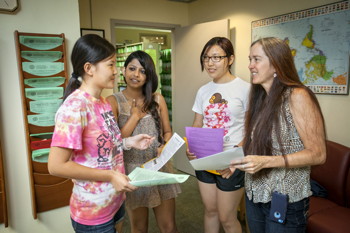
Students lending a hand (and ears, shoulders, etc.)
How upperclassmen help new students adjust to Cornell life
Giving the inside scoop
Each year before classes start, nearly 500 student volunteers serve as Orientation Leaders (OLs). Each helps a group of six to nine first-year students through the critical days between move-in and the start of class, taking them on tours of campus and giving academic pointers. Some favorite tips from OL Marcus Foo '15: "Temple of Zeus is known for its soups. The first prelim is usually the easiest – ace it. If you don't like your adviser, find another." OLs love to share what they've learned themselves.
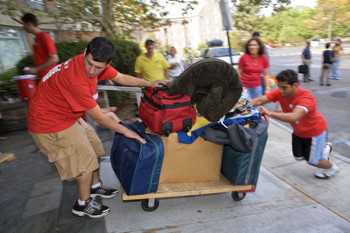
Students help new students move in at Cornell. See larger image
Listening, and just being there
Resident Advisers are trained to care for the well-being of their residents, in addition to enforcing university rules. "I had a hard time adjusting," says Ashley Rousseau '15, whose RA helped her through an especially rough freshman year. "My RA at the time noticed and talked to me about my academic situation." Now an RA herself, Rousseau makes a point to let the Balch Hall residents in her care know that her door is always open, no matter the issue.
Organized helping
During the 2013-14 year, nearly 500 students signed up for Campus Connection, a student organization that uses an online survey to connect upperclassmen with first-year students based on shared academic interests. Zach Praiss '16 and Blake Barr '16 founded the organization in fall 2013 to give back what they had received from their own mentors. "For both of us, upperclassmen played an invaluable role," says Praiss. "We wanted to provide that for any student."
For fall 2014 Orientation, Campus Connection reached out through Facebook, sidewalk chalk and the student organization fair to reach the group's growth goal: "We want to be something all first-year students know about."
– Kate Klein
1979 topped them all in 2014

Group photo of members of the Class of 1979 at Reunion 2014. Image: Joe Scaglione/photography4d.com
Rah, rah, rah! (plus a lot of legwork and planning and emailing) Why do some Cornell Reunion classes rally together and give back big time, while others putter and languish in the fundraising realm? If you ask folks responsible for the Class of 1979's record-breaking stats this Reunion year (they had 134 donors at the Tower Club level – $5,000 and above – beating the Class of 1977's record of 122 for any class at any reunion, set back in 2002), you'll hear the same answer again and again: "the two Jeffs." They would be Jeff Berg '79, former class president and current major gifts committee member, and Jeff Weiss '79, former major gifts chair and current class president. And if you ask Berg the secret to success, you'll get a detailed set of instructions, because he lives and breathes this stuff. "We didn't get to 134 Tower Club donors by accident," Berg says. Required factors include, he says, "great staff support," and the fact that Weiss set the goal of 125 Tower Club donors a full 18 months before Reunion. Also: "We, over the years, developed a very generous and loyal set of classmates. You get to 130-plus Tower Club donors in a reunion year by first having several consecutive non-reunion years with over 100 Tower Club donors." Final two factors: "an extremely hardworking major gifts team of over 20 classmates," and "good stewardship of past Tower Club gifts, including a tradition of handwritten thank-you notes from Major Gifts Committee chairs." Candid of members of the Class of 1979 at Reunion 2014. Image: Provided. See larger image Weiss explained that members of the Class of '79 "are a fun bunch" and that they have multiple approaches to increasing engagement. "We celebrated 90 distinguished classmates for accomplishments across eight fields, travel together, regularly party and have a memorial fund for departed classmates. And then we asked and asked." In addition to the all-time Tower Club record for any class, the Class of '79 also had more donors than any of this year's reunion classes: 795 alumni made gifts. (The all-time 35th reunion donor participation record is 857, set in 2008 by the Class of 1973.) Together, members of the Class of 1979 gave gifts to their alma mater totaling more than $33.4 million in fiscal year 2014. Mark Wilson '79, reunion campaign committee co-chair, who was roped into class engagement "three jobs ago" by Berg, says: "The real thing is to get people engaged, to stay in contact all the time. When I look back, we all had student loan debt (of course it pales in comparison to today), and back then we might have thought, 'Why should I give the university any money?' But as you get older and hopefully more successful, you can pay it forward. You realize it really was a good experience." The class reached its numbers, Wilson explains, by sending many appeals for support, by email and paper mail, on the phone and in person. Working in their favor, he points out, was age. "From a fundraising point of view," he says, "people's love tends to get better as they get older." Case in point: Cindy Green '79, Wilson's reunion campaign committee co-chair, who says: "Cornell is my most favorite and revered institution on the planet. The amazing instruction I received from the outstanding Urie Bronfenbrenner and [College of Human Ecology] Dean Jerry Ziegler accounts for my ability to receive a Ph.D. and develop a successful, fulfilling public policy career. The connections I made at Cornell set me on a special trajectory and enabled my life to be amazing and happy and filled with so many lifelong friends, a wonderful husband and the three best children imaginable. "In recognition of what Cornell did for me, I want to strongly memorialize the people who made this possible: my teacher mom and social worker dad, who took on second jobs. And I want to give back to the institution to ensure that it continues to have the resources so that future students can continue to experience what I did." That's paying it forward and back.
Philanthropic parents
His son's disease inpires a parent to support research
Ray and Kathy Mills are Cornell parents whose son, a junior in the College of Arts and Sciences, has been having a great experience at Cornell; he also has Emery-Dreifuss muscular dystrophy (EDMD).
EDMD is one of the rarer forms of muscular dystrophy and affects skeletal muscles used for movement and cardiac muscle. Heart problems affect nearly all people with EDMD by adulthood due to abnormalities of the electrical signals that control heartbeat and heart rhythms.
Ray and Kathy Mills support research on the disease and recently discovered that Jan Lammerding, assistant professor in the Department of Biomedical Engineering and at the Weill Institute for Cell and Molecular Biology at Cornell, is researching EDMD.
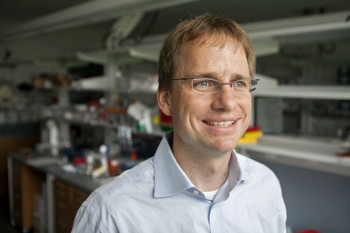
Jan Lammerding, assistant professor in the Department of Biomedical Engineering. See larger image
The Lammerding lab's specialty is subcellular biomechanics and the cellular signaling response to mechanical stimulation; his work studies the interplay between cellular structure and function and how defects in nuclear structure and organization can contribute to numerous diseases, including EDMD.
The Millses recently made a gift to Lammerding's research on EDMD.
"I like the way he is cross disciplinary – an engineer by training," Mills says of Lammerding. "He is bridging the divide between engineering and biology, and often advances come from people from one field applying their knowledge to another, or bridging a gap between fields.
"He has a very positive approach to things; he is an upbeat person, engaging," Mills says. "He has a great group of students, undergrad and grad, working for him; he is a good leader, a team builder, a motivating person. And I think those are all things that lead to good research."
"The recent funding cuts to the National Institutes of Health directly affect our research by limiting available resources," Lammerding says. "Thanks to the generous support from the Mills family, we were able to expand our research efforts on EDMD and to develop new tools to identify the underlying disease mechanism, while also providing two Cornell students the opportunity to gain valuable research experience on EDMD in the lab over the summer."
More than 5,800 parents of current Cornell undergraduates made gifts to the university this past fiscal year, supporting everything from medical research and the Cornell Annual Fund to athletics and undergraduate scholarships.
"Parents are unique in having a front-row seat, in a way, to what makes Cornell an amazing place to study and live," said Penelope Chick, director of parents programs for Alumni Affairs and Development. "Sometimes even more than their children, parents realize how privileged we all are to take part in the discovery and community that make up Cornell."
– Joe WilenskyMatching gift poses historic challenge
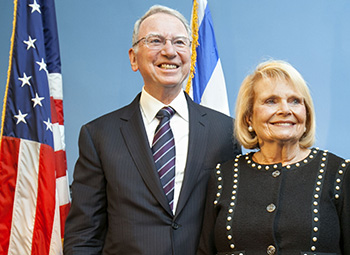
Joan Klein Jacobs '54 and Irwin Mark Jacobs '54. See larger image
The College of Human Ecology has received its largest gift ever: $10 million from longtime Cornell supporters Joan Klein Jacobs '54 and Irwin Mark Jacobs '54, founding chairman and CEO emeritus of Qualcomm, in support of faculty renewal. "It could not have occurred at a more strategic time for Human Ecology," said Alan Mathios, the Rebecca Q. and James C. Morgan Dean, "as we are in the midst of an unprecedented faculty renewal. The gift's matching nature allows us to leverage support from other alumni and friends far into the future, and the Jacobs' gift will be remembered for helping to launch the great success of Human Ecology and Cornell into our sesquicentennial year and beyond. In addition to fully endowing the Joan K. and Irwin M. Jacobs Professorship in the College of Human Ecology and a supporting Joan K. and Irwin M. Jacobs Graduate Fellowship, the couple has committed $6 million in matching funds to inspire other alumni and friends to establish four more faculty endowments in the college. With gifts of $1.5 million each, other donors can establish and name a professorship. Mathios will use the professorships to retain senior faculty or recruit top scholars in fields associated with the college's eight multidisciplinary research themes: community and family policy, economics and federal policy, fashion and technology, health and design, lifespan development, neuroscience, public health and nutrition, and sustainability "Irwin and I are pleased to support the College of Human Ecology in furthering its teaching and multidisciplinary research across a broad range of natural, social and environmental issues," Joan Jacobs said. "As an alumna, I have benefited greatly from the education that I received and am pleased to help provide a similar outstanding opportunity to future students. We are delighted that this gift will bolster faculty renewal during a critical time for the college, and hope that it inspires others to support Human Ecology's teaching, research and outreach mission." Joan Jacobs, a nutritional sciences graduate, and Irwin Jacobs, an electrical engineering graduate, have a long history of generosity to Cornell. Last spring, they gave $133 million to Cornell and the Technion – Israel Institute of Technology to create the Joan and Irwin Jacobs Technion-Cornell Innovation Institute at Cornell Tech in New York City. They have also established the Irwin M. and Joan K. Jacobs Scholars and Fellows Programs and the Irwin and Joan Jacobs Professorship, both in the College of Engineering, as well as the Joan Klein Jacobs Cornell Tradition Fellowship in the College of Human Ecology.
– Ted Boscia
RELATED INFORMATION:
College of Human Ecology
Human Ecology Research Themes
Brother, can you spare 10 million dimes?
The United Way of Tompkins County raises 40 percent of the total Tompkins County campaign from Cornell staff and faculty. This year, that amounted to $815,000. Most of the money came in modest donations deducted from individuals' paychecks – $7 a month here, $20 a month there, but from thousands of people. And it's tough times, economically, in Tompkins County for many families, making this support truly critical and appreciated. In any given year, thousands of Ithaca and Tompkins County residents – including Cornellians – receive assistance from the more than 40 United Way agencies. Staff, faculty and student United Way donations can be given for any need or targeted to specific needs. For example, contributions to the United Way's Community Care Fund go to local agencies addressing needs in child care/ early learning; youth; basic needs; crisis services; health/ environment; financial stability/building self-sufficiency; and seniors. Dozens of United Way agencies and other nonprofit organizations in Tompkins County have at least one Cornell staffer, faculty member or student on its board. And each fall, about 14,000 pounds of nonperishable food, personal care items, and pet and school supplies are collected on the Cornell campus and elsewhere in the in the county for the annual Stephen E. Garner Day of Caring. In 2011, the Student United Way of Cornell University won the first-ever United Way Worldwide Student United Way Campus Organization of the Year award, and has since been honored several additional times. "United Way agencies and the many Ithaca-area residents who work there, support them or benefit from their services are an essential part of our community's strong and diverse fabric," says Ithaca Mayor Svante Myrick '09. "I appreciate Cornell's commitment to United Way of Tompkins County, from its nationally recognized student campaign to campuswide leadership that encourages staff and faculty to give and engage at the local level." Myrick, who volunteered for the Cornell Student United Way Campaign as an undergraduate, has been an active voice for United Way, in part because of the help his family received while he was growing up in Earlville, N.Y. He knows firsthand that philanthropy is an important component of a functional society and can make a difference between success and failure.
"The story of Ithaca and Tompkins County is not just about high-profile leaders acting alone, but of thousands of people working behind the scenes," he says. "It's what makes our many communities, including the campuses, worth living in and working for."
The right doctor in the right place at the right time
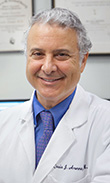
Dr. Louis Aronne. Image: Weill Cornell Medical College. See larger image
Lunchtime. A crisp, sunny day in early April. Dr. Louis Aronne is walking the five blocks from New York-Presbyterian/ Weill Cornell Medical Center to his office when he sees someone familiar running toward him. It's the manager of the parking garage where Aronne, a world-renowned internist and obesity expert at Weill Cornell Medical College, parks his car every morning. One of the guys in the garage is sick, the manager shouts out. Can you help? Dr. Athos Patsalides. Image: Weill Cornell Medical College. See larger image. Aronne rushes into the garage and finds Errol Mair, a friendly, longtime parking attendant he immediately recognizes, in a chair, his left side paralyzed. Aronne knows right away what's wrong: a stroke. After ascertaining that an ambulance, which has already been called, might take too long, Aronne urges worried co-workers to get Mair into a car to be rushed to the nearby Weill Cornell emergency room. Aronne rides in the back seat and jumps out at the ER patient entrance. Following quick administration of medication, Dr. Athos Patsalides, a Weill Cornell neurosurgeon, operates on Mair and lasers the life-threatening clot. Later, asked about his role in saving Mair's life, Aronne answers simply: "That's what we do."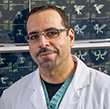
A dog in need inspires a human to give
Last September, Debbie Boone of Walworth, N.Y., brought her Labrador, Leo, to Cornell University's Hospital for Animals for evaluation after a radiograph taken by her local veterinarian revealed an abnormality in his stomach. The news got quickly worse. Cornell veterinarians suspected hemangiosarcoma, a rapidly growing, highly invasive variety of cancer not only serious, but also potentially expensive to treat, with surgeries running upwards of $3,000. Boone, who is disabled due to a spinal injury that restricts her employment and income opportunities, was willing to do anything to save Leo. With her savings, help from the College of Veterinary Medicine's patient assistance program, Friends & Vets Helping Pets, and Emma's Foundation for Canine Cancer and people described by Boone as "people who knew and loved Leo, and people who knew how much he meant to me," Leo had his surgery in November. Leo the dog. Image: provided.See larger image The patient assistance program is open to anyone in need and generally pays between 5 and 30 percent of medical expenses. In the application process, program staff members determine a pet owner's income versus bills, family size, job status and other criteria to make a decision on how much to fund. The program is supported by donors, an endowment and fundraisers, such as the student-initiated "Pedal for Pets" annual bike ride. Fortunately for Leo, the surgery revealed he did not have life-threatening cancer, but a hematoma on his spleen, possibly from a fall or a run-in with a deer, which had given him a fractured rib. The veterinarians removed the spleen, and Leo is thriving at the age of 14. "Debbie's dedication to her animals in the face of all the challenges was heartwarming," says Sarah Bassman, client services coordinator at the college, who works with client services manager Wendy English to identify pet owners in need. Boone's "drive to find a way, her willingness to do whatever she could for her friend Leo," stood out for Bassman. "If Cornell were 30 minutes away instead of two hours, I would bring every animal I have" to the Hospital for Animals, she says. The experience has renewed a commitment in Boone to help others. She is now helping a local wildlife rehabilitator in her community, Carrie Leo of Caring for Cottontails, who helped Boone by caring for her other dogs while Boone was at Cornell with Leo. "Carrie came over for no charge at all, and helped me out," Boone says. "She needs help, and I know what it's like when you're on your own, and I try to help where I can." Boone is now fundraising and soliciting local support for the wildlife rehabilitation facility in Walworth Ð for example, working with a nearby Home Depot to donate lumber, stone and trucking for a fox enclosure. "People really stepped up for me, and I never saw that coming," says Boone, who describes her commitment as a way of "paying it forward." "It just was like a building block, or a domino effect that started with Cornell helping me out, and then it just happens, slowly but surely, and I saw how that was possible," she says. "So now I try to be somebody who does that, too." Donations of all sizes for the patient assistance program will continue to allow families to face treatment decisions with less hesitation, knowing that a generous community has provided needed financial support.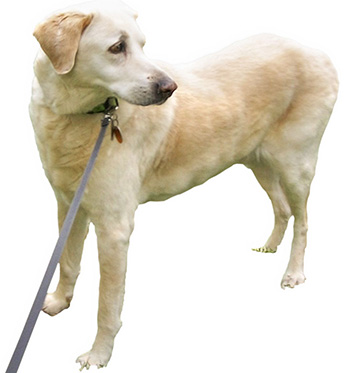
A deep appreciation for business education
Professor David BenDaniel See larger image It sounds odd to hear it now, but Stephen Smith '91, MBA '95, did not fit in at business school.
"I was a fish out of water," he says. Unlike his Wall Street-and investment bank-bound classmates, he always had an aspiration to start his own business, and entrepreneurial aspirations were less common in those days.
He soon found his place, however, in entrepreneurship classes at the Samuel Curtis Johnson Graduate School of Management, particularly those taught by Professors David BenDaniel and Vrinda Kadiyali.
"BenDaniel's class gave me permission to be a bit of an oddball at the business school," he says. "I loved that."
While still a student at Johnson, Smith found a business partner – a graduate engineering student – and together they developed projects. The friendship and working partnership continued after Smith earned his MBA.
One of their projects was Naviance, a company that produces software to prepare high school students for college and career choices through academic planning, test preparation and career exploration services. Smith gained a deep appreciation for education from his father, a high school English teacher and principal.
In 2001, Smith decided they had a chance to make Naviance into an independent company.
Professor Vrinda Kadiyali See larger image "It was a pretty big leap," says Smith, who left his position as a vice president at Peterson, a division of the information company Thompson-Reuters, to start Naviance.
The Jonas Weil Entrepreneurial Fellowship at Johnson helped Smith pay off his student loans during the first critical two years, when neither he nor his business partner took any salary.
The risk paid off. In 2007, Naviance was acquired by Hobsons, an education marketing services company with a global presence.
"It was a natural fit," says Smith. He now heads up the Naviance division of Hobsons. Leading a company that sells materials to help high school students apply for, get into and make the most of college, he says, is a perfect marriage of his two great professional interests – education and entrepreneurship.
To encourage recent Johnson graduates to pursue their own entrepreneurial dreams, Smith has committed a major gift to the Jonas Weil Fellowship that helped him pay back student loans while he started a new business.
"That was investing capital in the business," he says of his Weil Fellowship. "I wanted to return that."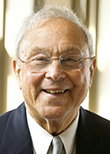
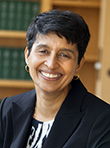
Passing along a passion for poetry
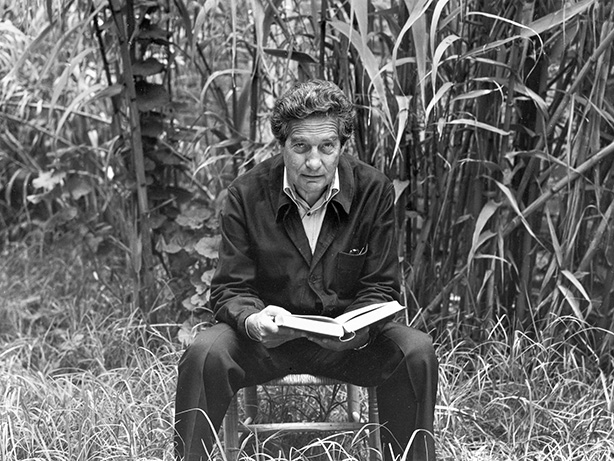
Octavio Paz. Image: Manuel Alvarez Bravo.
In 1966, Mexican poet Octavio Paz (pictured above), who would win the 1990 Nobel Prize in literature, was teaching at Cornell. When the time came for him to give a public reading of his Spanish poems, he chose his student Stephen Meringoff '66, an electrical engineering major, to read the English translations. Stephen Meringoff '66. See larger image "I was terrified," says Meringoff, now chairman of a commercial real estate firm in New York. "Fortunately I performed as he asked," and the reading was a success. While Meringoff studied electrical engineering and business at Cornell, he kept his courseload diverse, taking many humanities courses, and Paz was a memorable professor. "To be around him was a joy," Meringoff says. Assistant professor Ishion Hutchinson, the new Meringoff Sesquicentennial Fellow. See larger image The poetry course he took with Paz still resonates with Meringoff, and his love of literature has been embraced fully by Meringoff's daughter Tory Meringoff '08, who majored in English at Cornell and is a writer and writing teacher. She, along with her father and three sisters, form the board of the Meringoff Family Foundation, which focuses its philanthropy on educational projects. "He's taught us a love of giving," says Tory Meringoff. When Stephen Meringoff had the opportunity to endow a Sesquicentennial Faculty Fellowship at Cornell, he chose to do it in the English department, in honor of Tory, and to give future Cornell students – no matter their major or college – the opportunity to be inspired by assistant professor and poet Ishion Hutchinson, the new Meringoff Sesquicentennial Fellow, the way Meringoff was once inspired by Paz.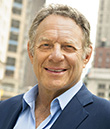
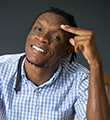
The gift of a trip across the pond
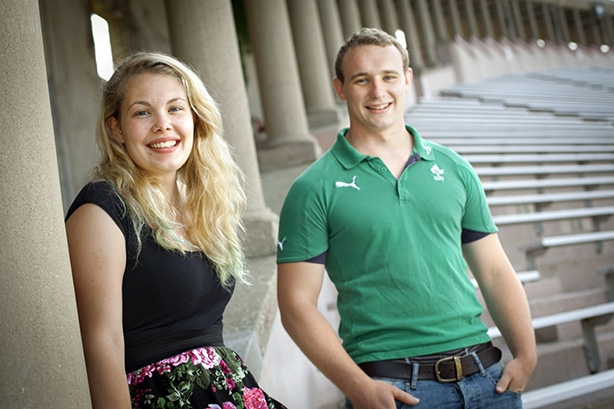
Rebecca Howe and Perry Wilson.
For the past 22 years, the Cornell Club of London has sponsored college students from the United Kingdom to live and study in Ithaca during Cornell's summer session. Managed and funded wholly by alumni, the scholarship seeks to make the award to students who may not otherwise have such an opportunity. Upon their return to the U.K., recipients prepare a written report and are asked to address the club's annual Thanksgiving dinner. As longtime Cornell Club president (and new member of the Most Excellent Order of the British Empire) Natalie Teich '65 put it: "This scholarship is a personal gesture by the Cornell Club of London alumni and awarded to a select few to experience firsthand America and American academia at their beloved Cornell." This year the club chose two recipients (pictured above): Rebecca Howe , who is in her second year at Pembroke College, Oxford University, studying history. She is president of the Pembroke Junior Common Room and is interested in international politics; and Perry Wilson, a third-year student at the University of Manchester studying civil engineering. He is captain of the university's Rugby Union Club, where he manages several teams. Bucking the trend, the 2014 scholarship process was taken "offline" with applicants required to submit their forms by mail. While this may have reduced the number of candidates, the quality of those received was far higher, club officials say. The club plans to form a group of the scholarship recipients from the last 22 years to act as stewards of the program in the future.
Building better computers, walls, diapers ...
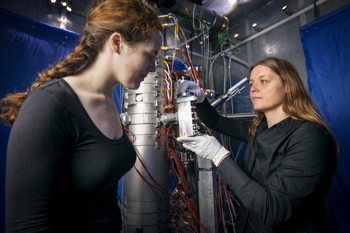
Lena Kourkoutis (on right), director of an electron microscopy group in the College of Engineering, works with a student in CCMR. See larger image
A team of Cornell researchers in physics, applied physics and electrical engineering, working with colleagues from Penn State, Israel and Saudi Arabia recently discovered the first important application of topological insulators: The material acts as an interior insulator but conducts electricity on the surface in an unusual way. Introducing magnets to these materials, the researchers have discovered, creates new possibilities for developing magnetic memory that could ultimately lead to smaller, faster computers. This is an example of the work in the materials science realm, where researchers investigate substances at the atomic level, looking deep into electrons and molecules to create or improve materials we use every day, or even take for granted – for instance, disposable diapers. Melissa Hines, director of the Cornell Center for Materials Research. See larger image "That's super-absorbent material," says professor Melissa Hines, director of the Cornell Center for Materials Research (CCMR), on the value of just one ubiquitous product made possible by advances in materials science. A century of materials research has gone into developing super-strong Gorilla Glass in smartphones and the work to develop the microprocessors in computers from silicon. Molecule model image. Image: iStockphoto. See larger image CCMR leads the world in materials research in part because of the foresight and generosity of Robert L. Sproull, a visionary scientist and administrator who worked at Cornell from 1946 to 1968. The former physics professor helped launch CCMR in 1960 and served as its first director. Sproull and his wife, Mary, established a $1 million endowment in 2005 to benefit CCMR. "He expected it to be viewed as a modest endowment, with income to be used at the director's discretion," says Sproull's son, Robert Sproull Jr. Hines currently administers the endowment, which can be used, for example, to fund symposia or supplement federal government grants for costly equipment. When Sproull helped found CCMR, the focus of materials research was metals, says Hines. Nearly 60 years later, the focus is on atomic properties of organic and nonorganic materials, and the research has become much more interdisciplinary.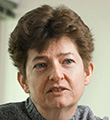

A site for volunteers, who make the world go 'round
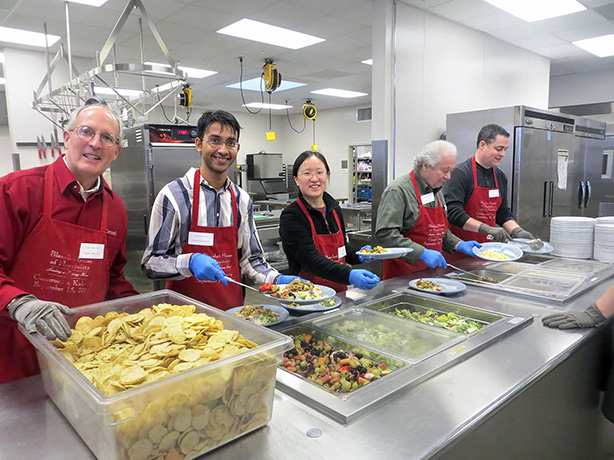
In Portland, Ore., members of the Cayuga's Waiters helped serve a meal and then performed at the Blanchet House soup kitchen in January 2014 as part of Cornell Cares Day. Image: Mary Lang.
Before it could be fully launched in September, a new, online volunteer platform built for Alumni Affairs and Development had to be shared with and tested by key alumni stakeholders, like Class of 1955 Treasurer Michael Avery. "A year ago," Avery admits, "I became aware of the effort for this new system and, to be honest, was less than positive about it." But seeing was believing. "After realizing what this system will accomplish," he says, "I think it will be a marvelous tool that will greatly enhance volunteer opportunities throughout the world, both for alumni and undergrads." Partial screenshot of CUVolunteer website. Image: provided. See larger image CUVolunteer (alumni.cornell. edu/volunteer) connects alumni (and soon, students) with ways to pitch in for Cornell that are best suited to their interests, skills and availability – whether it's volunteering an hour or two as an event usher, hosting a brunch for prospective students or taking on the role of class officer. It's an online matchmaking platform and social network for Big Red aficionados. After users have created their profiles – indicating their location, expertise, Cornell affinities and general interests – the system provides them with matching volunteer opportunities. Users can then nominate themselves, or other users, with a click. The complexity of Cornell's vast volunteer network and the need for greater transparency and coordination prompted the creation of CUVolunteer, says Laura Denbow, senior director of Cornell's Office of Volunteer Programs. In 2012, OVP and the Trustee Task Force on Volunteer Leadership, led by Diana Daniels '71, hatched the original idea and, from a pool of competing vendors, selected GiveGab – a company co-founded by Charlie Mulligan, MBA '11; Aaron Godert, M.Eng. '05, MBA '11; and Chris Beeman. OVP enlisted the help of professor Debra Perosio '79, MPS '92, Ph.D. '95, and students in her marketing plan development class at the Dyson School to name the platform. OVP expects CUVolunteer to boost and streamline participation – for instance in January's Cornell Cares Day, which features many "done-in-a-day" opportunities. CUVolunteer currently hosts close to 12,000 volunteer communities, over 3,200 position descriptions and more than 33,000 opportunities on campus, across the nation and around the world. Denbow expects these numbers to increase even more.
"We were charged with building a really strong house, and I believe we've accomplished that," Denbow says. "Now, it's our volunteers' turn to make it their home."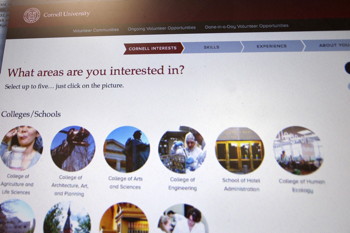
Ezra "do the most good" Cornell
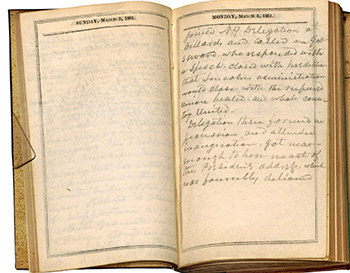
Ezra Cornell's pocket diary, 1861. Image: Division of Rare and Manuscript Collections. See larger image
The founding of Cornell University was due in large part to the generosity of Ezra Cornell, a man who lived most of his life with very little formal education or wealth. When his fortunes changed with the success of the telegraph industry, he was quick to direct his newfound prosperity back to his community. In 1858, Cornell purchased books and journals to create an Agricultural Reading Room for Tompkins County, and as the Civil War broke out, he led and contributed to local war relief efforts. His first major philanthropic endeavor was building and endowing a public library for Ithaca and Tompkins County in 1863, to provide free access and education to all. Cornell University founder Ezra Cornell in 1868. See larger image. Having finally achieved success after a life of hardships, Cornell returned in his 50s to his childhood "cyphering book," a book of blank pages that he bound together at age 16 for practicing arithmetic, from simple addition and subtraction to calculating interest and annuities. In 1864, Cornell noted in the book that his yearly income now exceeded $100,000 (about $1.5 million today). Cornell's first president, Andrew D. White. See larger image. Realizing he was so wealthy led Cornell to write one of his most profound statements – a philanthropic attitude that continues to inspire benefactors today: "My greatest care now is how to spend this large income, to do the most good to those who are properly dependent on [me] – to the poor and to posterity." Within the next year, Cornell had devised the perfect outlet for his philanthropy, inspired in part by the 1862 Morrill Land Grant Act and his colleague in the New York State Senate, Andrew Dickson White. With a gift of $500,000 and his farmland in Ithaca, Cornell would found his eponymous university in 1865, an institution that changed the face of higher education by aspiring to educate "any person" in "any study." Twenty-five years later, during Founder's Day celebrations honoring the anniversary of Ezra Cornell's birthday, White described Cornell to a new generation of Cornellians: "He sought no reputation as a philanthropist, cared little for approval and nothing for applause; but I can say of him, without reserve, that, during all the years I knew him, he went about doing good."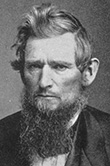
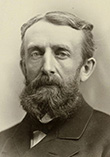
Research explores effects of the chain of generosity
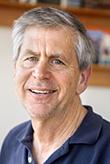
Michael Macy, the Goldwin Smith Professor. See larger image.
There's a difference between "paying it forward" and giving back, says Michael Macy, the Goldwin Smith Professor of Arts and Sciences in Cornell's departments of sociology and information science. When you pay it back, you are giving a gift to the same person or institution that earlier gave a gift (or assistance) to you. On the other hand, when you pay it forward, you are giving to a new, sometimes unrelated recipient. Case in point: those chains of giving at drive-through windows, as in 2012 in Winnipeg, Manitoba, when 226 Tim Hortons customers in a row picked up the bill for the customer next in line. That's 225 consecutive acts of paying it forward to a stranger. Some of us think of our gifts to our alma mater as paying it back to the institution that educated us; some of us think of it as paying it forward to a new generation. However you look at it, generosity has big repercussions on those around us, says Macy. "When you are generous to somebody else, you are actually benefiting not just that person, but who knows how many people downstream," Macy says, because his research, conducted with graduate student Milena Tsvetkova, has shown that people become more generous when they witness generosity and when they are a recipient of generosity. And being the recipient of generosity protects people from "the bystander effect," where witnessing multiple or consecutive acts of generosity makes people feel that their assistance is probably not needed.
